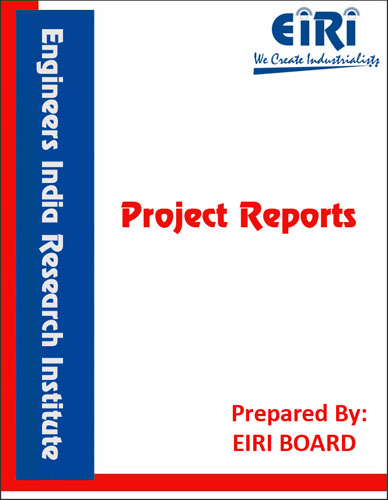The project report includes Present Market Position and Expected Future Demand, Market Size, Statistics, Trends, SWOT Analysis and Forecasts. Report provides a comprehensive analysis from industry covering detailed reporting and evaluates the position of the industry by providing insights to the SWOT analysis of the industry.
PROCESSING UNIT OF LARGE CARDAMOM
[CODE NO. 2039]
Large Cardamom :-
It is botanically classified as in Ammonium Linn.
Ammonium Linn :-
A large genus of rhizomatic herbs, 3-12′ high, comprising 100 palaeotropical species, of which 30 are met with in India and Burma.
The spicy aromatic seeds of some species of ammonium, also called cardamoms, are cheaper substitutes for true cardamom (Elettaria cardamomum), which they resemble. A. aromaticum and A. subulatum are cultivated in India.
The seeds of A. xanthioides Wall., Malabar or Tavoy cardamom (Burma, Siam, and the Malay Peninsula), are imported. They are pale brown, somewhat smaller in size than true cardamom seeds, and possess a strong but agreeable odour.
HIND. BENG.- Morang elaichi; MAR. – Veldoda :-
A herb, 2-3′ high, indigenous to East Bengal and Assam and distributed to surrounding areas. It is cultivated in the wetter districts of Bengal and Assam, at the foot of the Himalayas. The fruits are produced on pendant spikes. They are narrowly obovoid (1.5″ long) and 3 valved, with numerous seeds in each cell.
The seeds are used as spice and are medicinal. They yield about 1-1.2 % of oil (sp. gr., 0.92; [a]D – 13o) containing a large quantity of cineol. This oil does not possess the characteristic odour of cardamom.
A. subulatum Greater or NEPAL CARDAMOM
BENG.- Bara elachi (Large cardamom)
This species is cultivated in swampy places along the sides of mountain streams, in Nepal, Bengal, Sikkim and Assam.
The dark red-brown globose capsules (1″ long) contain several seeds in each cell, held together by a viscid sugary pulp. The seeds possess properties similar to those of cardamom for which they are often substituted. They are used in the preparation of sweetmeats. In medicine, they are fragrant adjuncts to other stimulants, bitters and purgatives. Oil extracted from them is applied to eyelids to allay inflammation.
Amomum subulatum Roxb (Zingiberaceae), commonly known as large cardamom, is a percennial herbaceous plant with subterranean rhizomes which produces several leafy shoots and panicles. It is a native to Sikkim and from there it is spread to neighboring areas like Darjeeling, Assam, Bhutan and Nepal, India is the largest producer of large cardamom with an annual production of 4000 MT, followed by Nepal (2500 MT) and Bhutan (1000 MT). Sikkim state of India alone contributes 50% of the world’s production of large cardamom. The fruit is a trilocular many seeded capsule. It contains 1.95 to 3.23% of essential oil having typical characteristic flavor and possesses stimulant, stomachic, alexipharmic and astringent effects. The fruits are prescribed to treat indigestion, vomiting, biliousness, abdominal pains, rectal diseases, throat troubles, congestion of the lungs, inflammation of the eyelids, digestive disorders, pulmonary tuberculosis, loss of appetite, gastric troubles, and liver complaints. Due to its pleasant aroma, it has been used as an essential ingredient in mixed spices. The major constituent of large cardamom essential oil is 1,8-cineole (65-80%) while the content of terpenyl acetate is low (traces to five per cent). The monoterpene hydrocarbon content is in the range of 5-17% of which limonene, sabinene, and the pinen are significant components. The terpineols comprise approximately five to seven per cent of the oil. The high cineole and low terpenyl acetate probably account for the very harsh aroma of this spice in comparison with that of true cardamom.
INTRODUCTION
HABITAT AND DESCRIPTION OF LARGE CARDOMOM
USES AND APPLICATION
GRADE SPECIATION OF LARGE CARDAMOM
PHYTOCONSTITUENTS QUALITY AND PROPERTIES
MARKET SURVEY
EXPORT DATA OF BIG CARDAMOM
PRODUCTION OF LARGE CARDAMOM IN INDIA
COMPARATIVE PERFORMANCE OF DIFFERENT
VARIETIES OF LARGE CARDAMOM
LARGE CARDAMOM PRODUCTION IN SIKKIM
PROCESSING OF LARGE CARDAMOM
PROCESS FLOW DIAGRAM
DETAILS OF PROCESSING OF LARGE CARDAMOM
DRYING CHARACTERISTICS OF LARGE CARDAMOM
POSTHARVEST PROCESSING OF LARGE CARDAMOM
DRYING METHOD FOR CARDAMOM
POLLUTION CONTROL MEASURES IN PROCESSING UNIT OF LARGE CARDAMOM 57
PLANT LAYOUT
PRINCIPLES OF PLANT LAYOUT
PLANT LOCATION FACTORS
EXPLANATION OF TERMS USED IN THE PROJECT REPORT
PROJECT IMPLEMENTATION SCHEDULES
SUPPLIERS OF PLANT AND MACHINERY
SUPPLIERS OF RAW MATERIALS
APPENDIX – A :
1. COST OF PLANT ECONOMICS
2. LAND & BUILDING
3. PLANT AND MACHINERY
4. FIXED CAPITAL INVESTMENT
5. RAW MATERIAL
6. SALARY AND WAGES
7. UTILITIES AND OVERHEADS
8. TOTAL WORKING CAPITAL
9. COST OF PRODUCTION
10. PROFITABILITY ANALYSIS
11. BREAK EVEN POINT
12. RESOURCES OF FINANCE
13. INTEREST CHART
14. DEPRECIATION CHART
15. CASH FLOW STATEMENT
16. PROJECTED BALANCE SHEET



